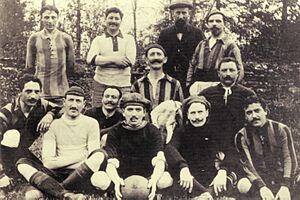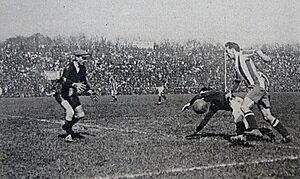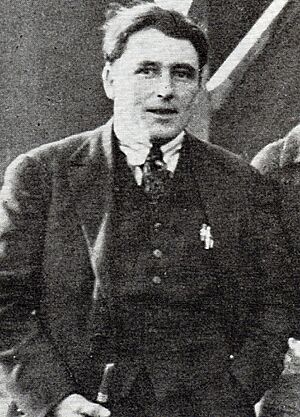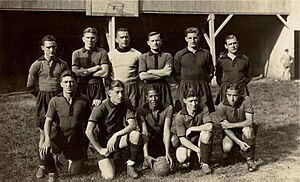History of Stade Rennais F.C. facts for kids
Stade Rennais F.C. is a French football club from the city of Rennes. This article tells the story of the club, from when it started to today.
Contents
How the Club Started
Early Days of Stade Rennais
Stade Rennais was created on 10 March 1901 by former students in Rennes. Their very first game was two weeks later against FC Rennais, which they sadly lost 6–0. In 1902, the club became an "Omnisport" club, meaning it included many sports. It also joined the USFSA.
The next year, Stade Rennais helped start the Brittany Football League. They won this league in its first season, 1903. By the end of that season, they had also won the second "série" by beating FC Rennes 4–0 in the final.
Some important players for Stade Rennais in 1903 were Martin Peter, Langelier Montouan, Mr. Duchesne, Guilbert Ghis, Mr. Marcel, Mr. Leroy, Mr. Audren, and Mr. Jamin. Duchesne, Jamin, Peter, and Ghis were even among the students who first started the club in 1901.
On 4 May 1904, Stade Rennais and FC Rennais joined together. They formed a new club called Stade Rennais Université Club.
After this merger, Stade Rennais UC had one main rival in Brittany: the Union Sportive Servanaise. Stade Rennais UC almost won against them in 1905, 1906, and 1907. Because of this, President Sexer of SRUC hired a Welsh football player named Griffith. He became the player-manager-captain. Griffith had played in the English Football League for years. He brought an English style of managing and tactics to Stade Rennais. This helped them win the Brittany football league in 1908 and 1909.
However, Griffith's team could not win the title in 1910. US Servanaise became champions, two points ahead of Stade Rennais UC. US Servannaise kept winning for the next four years, taking five titles in a row. Stade Rennais UC always finished second, less than five points behind the champions.
During World War I, the Brittany league stopped. Rennes was allowed to play in the Allied Cup (Inter-federation French Championship) and the Rennes Cup. Griffith led his players to win the Rennes Cup easily. They also had some surprising wins against famous clubs in the Allied Cup. They reached the final by beating Le Havre 3–0 and Entente Suisse 5–0. The final game in Paris against FC Lyon was delayed. But in the end, the Rouge et Noirs (Red and Blacks) became Interfederal Champions of France with a big 7–1 win.
The next year, Rennes did well in the Interfederation cup but could not win the title again. Rennes became a strong national team. They won the Upper Brittany League in 1918. They also won the Allies Cup in 1916 and 1917. The time after the war was very successful for Stade Rennais UC. They were Western Champions in 1919, 1920, 1921, and 1923. Stade Rennais also reached the final of the French Cup in 1922. They lost 2–0 against Red Star Saint-Ouen. A famous player in the 1922 final was François Hughes. He was the first French international player for Rennes. Many thought he was one of the best French centre-forwards of his time.
In 1924, Stade Rennais Université Club joined with the Rennes Etudiant-Club. They kept the name Stade Rennais Université Club. That season was not good for the team. For the first time since 1907, Rennes finished outside the top two places in their league. They were 3rd in the Western Division.
The President of Stade Rennais, Isidore Odorico, brought several foreign players to the club. These included Lothka, Szabo, and Nico. But the team still could not win the Western Division. President Odorico had different ideas about amateur players and foreign player rules. These ideas did not fit with the Western Division's rules. Other teams like Stade Quimpérois and CSJB Angers became stronger. So, Rennes decided to leave the Western Division in 1929.
For three years, Stade Rennais Université Club was not part of the Western Division. They only played friendly games. However, they managed to play against good international teams. These included Sparta Prague, Slavia Prague, Austria Vienna, and Budapest. They also played against famous French teams like Red Star Saint-Ouen, Olympique de Marseille, and FC Sochaux-Montbéliard.
Becoming a Professional Club
Joining the Professional League
In 1932, the FFF started the French professional football league. President Odorico wanted the club to be professional. But the club was in a very bad financial state. They had missed three seasons of league football. Even though the club had many supporters in Rennes, their request to join the professional league was turned down. This was because their money situation was too weak.
Odorico convinced supporters to give money to the club. Once the club's money problems were solved, the FFF accepted Stade Rennais. They were one of the 20 clubs to play in the first season.
Rennes started well in professional football. They finished 6th in their first season. However, the club's money problems did not get better. By 1937, the town of Rennes had to give money to the club. The mayor was pressured by local businesses to help. When World War II began in 1939, the French football league stopped. Stade Rennais Université Club went back to being an amateur club. For two years, Stade only played in the French Cup. They also played friendly games against local teams. In 1941, Rennes played in the Occupied Area Division of the French League. But they finished a disappointing 7th out of 9 teams. The next season, Rennes showed they were still struggling. They finished 14th out of 16 in the North Zone Division.
In 1943, the Vichy government brought back the interfederal French football league. Rennes-Bretagne was one of the 16 regions in the league. Stade Rennais UC was the only team from Brittany that had been in Division 1. However, only two players from Stade Rennais were chosen for the squad: Henri Guérin and Jean Prouff.
These years brought more stability to the club. But the 1990–91 season was not good. This was despite having players like François Omam-Biyik and Arnold Oosterveer. The team was saved from being moved down to a lower league. This happened because OGC Nice and Stade Brestois were moved down for administrative reasons. The next year, in 1991–92, Rennes could not avoid being moved down. The club started playing young players from its youth academy. These included Sylvain Wiltord, Jocelyn Gourvennec, Ulrich Le Pen, and Laurent Huard. They were able to return to Division 1. On July 7, 1993, the Pinault group became the main sponsor of the club. The club has been playing in the top division since this date. During this time, the team had players like Marco Grassi and Shabani Nonda.
The Pinault Years
New Ownership and Strategy
In 1998, Breton businessman François Pinault bought the team. He was a big fan of the club. He gave the team strong financial stability. He was very ambitious from the start. Rennais bought expensive star players. These included South American Lucas Severino and Mario Hector Turdo for the Division 1 2000-01 season. But these players did not perform well. The team has now changed its strategy. It once again uses players from its youth academy. This academy is thought to be one of the best in France. At one point, it was the best for three years in a row.
In the Ligue 1 2004–05 season, Rennes finished in a good fourth place. This was their best position ever. It meant they automatically qualified for the UEFA Cup. In the 2005–06 season, they finished a disappointing seventh place. This was after a very close race for European competition spots in France. In the 2006–07 season, Rennes again finished in fourth place. They just missed out on a UEFA Champions League spot. This happened because Lille scored a goal in the 93rd minute of the last game. But they did get to play in the UEFA Cup the next season. This was even without important players like Alexander Frei and Kim Källström.
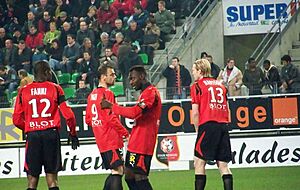
In 2007–08, Rennes qualified for the Intertoto Cup by finishing 6th. They had signed many new players. These included Jérôme Leroy, Sylvain Wiltord, Mickael Pagis, and Rod Fanni. Because of this, Rennes was seen as a strong team for the 2007–08 season. They started the season well, reaching 3rd place in November. But then they lost nine games in a row. This made them fall far down the table. However, the team fought back and finished the season in 6th place. Because of these losses, Pierre Dréossi left his coaching job. Guy Lacombe was hired as the new coach. Dréossi stayed on the staff as a general manager.
During the 2008–09 season, Rennes had an amazing 18-game unbeaten streak. They only lost one game, 1–0 away to Grenoble on 17 August 2008. The club ended up finishing the season in 7th place. However, Rennes reached the final of the famous Coupe de France in 2009. They played against En Avant de Guingamp. This match was a Breton derby (a game between two teams from the same region). It was played at Stade de France in Paris on 10 May. But Rennes lost 1–2, missing their chance to win the cup.
Rennes still sees itself as the top football club in Brittany. In 2009, they started a new club tradition. The unofficial national song of Brittany, the Bro Gozh ma Zadoù, would be played at the start of every match at the Stade de la Route de Lorient from September 2009.
For the 2010–11 season, Rennes began to refresh its main team. An agreement to transfer Moussa Sow to Lille OSC was completed in June. The arrival of Georges Mandjeck, Onyekachi Apam, Victor Hugo Montano, and Johann Carrasso was confirmed in the same month. The successful Colombian forward Víctor Montaño was also bought from Montpellier HSC for €6.5 million. He was expected to add a lot of attacking power. The Swedish defender Petter Hansson and the forward Jimmy Briand were sold. Hansson had played 102 matches for Stade Rennais, and Briand had played 169. They went to AS Monaco and Lyon respectively.


